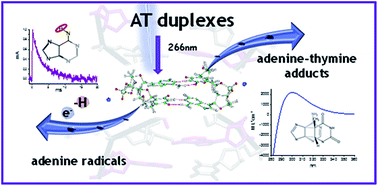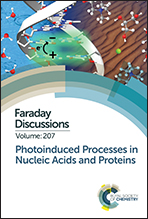Adenine radicals generated in alternating AT duplexes by direct absorption of low-energy UV radiation
Abstract
There is increasing evidence that the direct absorption of photons with energies that are lower than the ionization potential of nucleobases may result in oxidative damage to DNA. The present work, which combines nanosecond transient absorption spectroscopy and quantum mechanical calculations, studies this process in alternating adenine–thymine duplexes (AT)n. We show that the one-photon ionization quantum yield of (AT)10 at 266 nm (4.66 eV) is (1.5 ± 0.3) × 10−3. According to our PCM/TD-DFT calculations carried out on model duplexes composed of two base pairs, (AT)1 and (TA)1, simultaneous base pairing and stacking does not induce important changes in the absorption spectra of the adenine radical cation and deprotonated radical. The adenine radicals, thus identified in the time-resolved spectra, disappear with a lifetime of 2.5 ms, giving rise to a reaction product that absorbs at 350 nm. In parallel, the fingerprint of reaction intermediates other than radicals, formed directly from singlet excited states and assigned to AT/TA dimers, is detected at shorter wavelengths. PCM/TD-DFT calculations are carried out to map the pathways leading to such species and to characterize their absorption spectra; we find that, in addition to the path leading to the well-known TA* photoproduct, an AT photo-dimerization path may be operative in duplexes.

- This article is part of the themed collection: Photoinduced Processes in Nucleic Acids and Proteins


 Please wait while we load your content...
Please wait while we load your content...